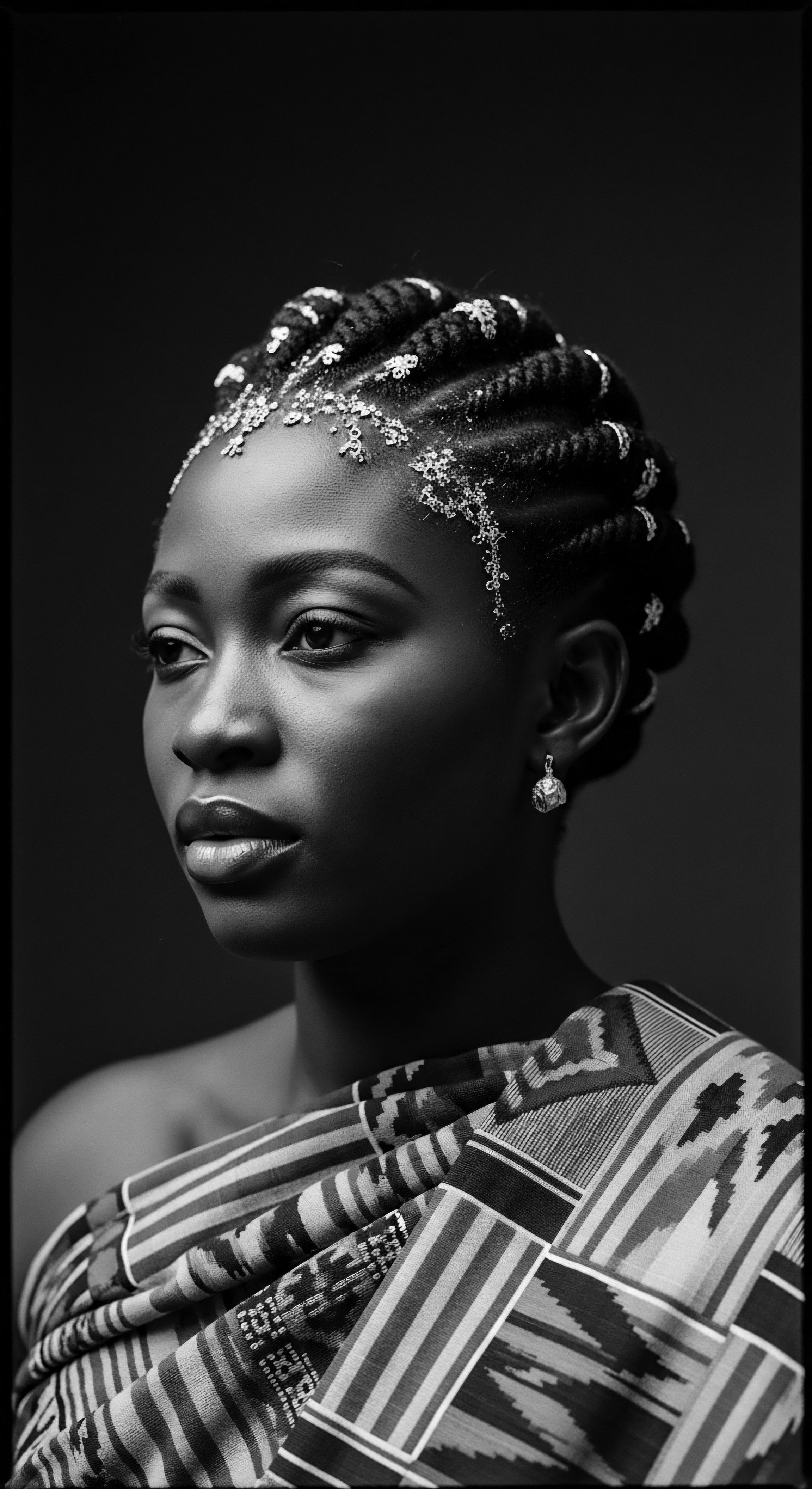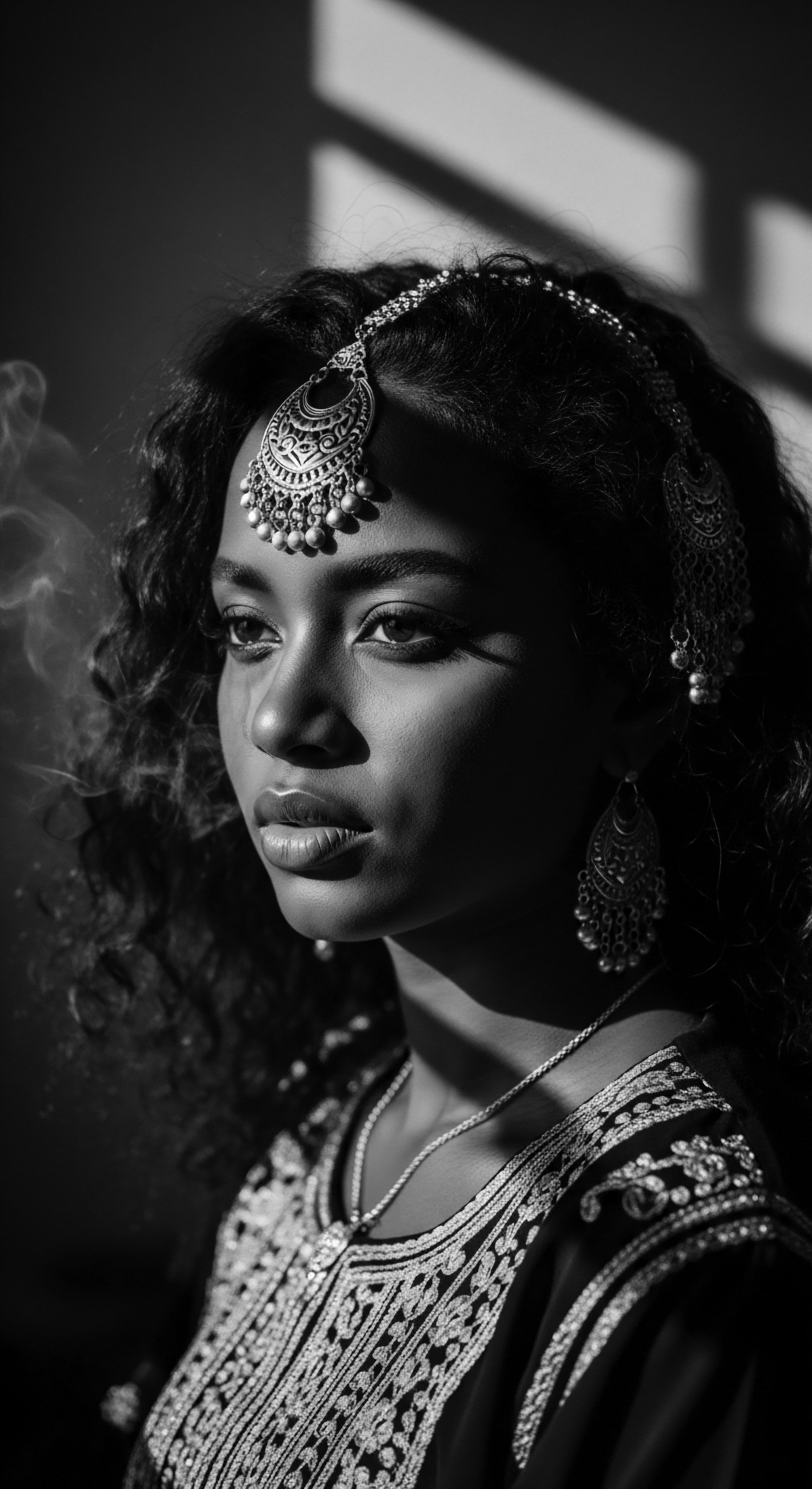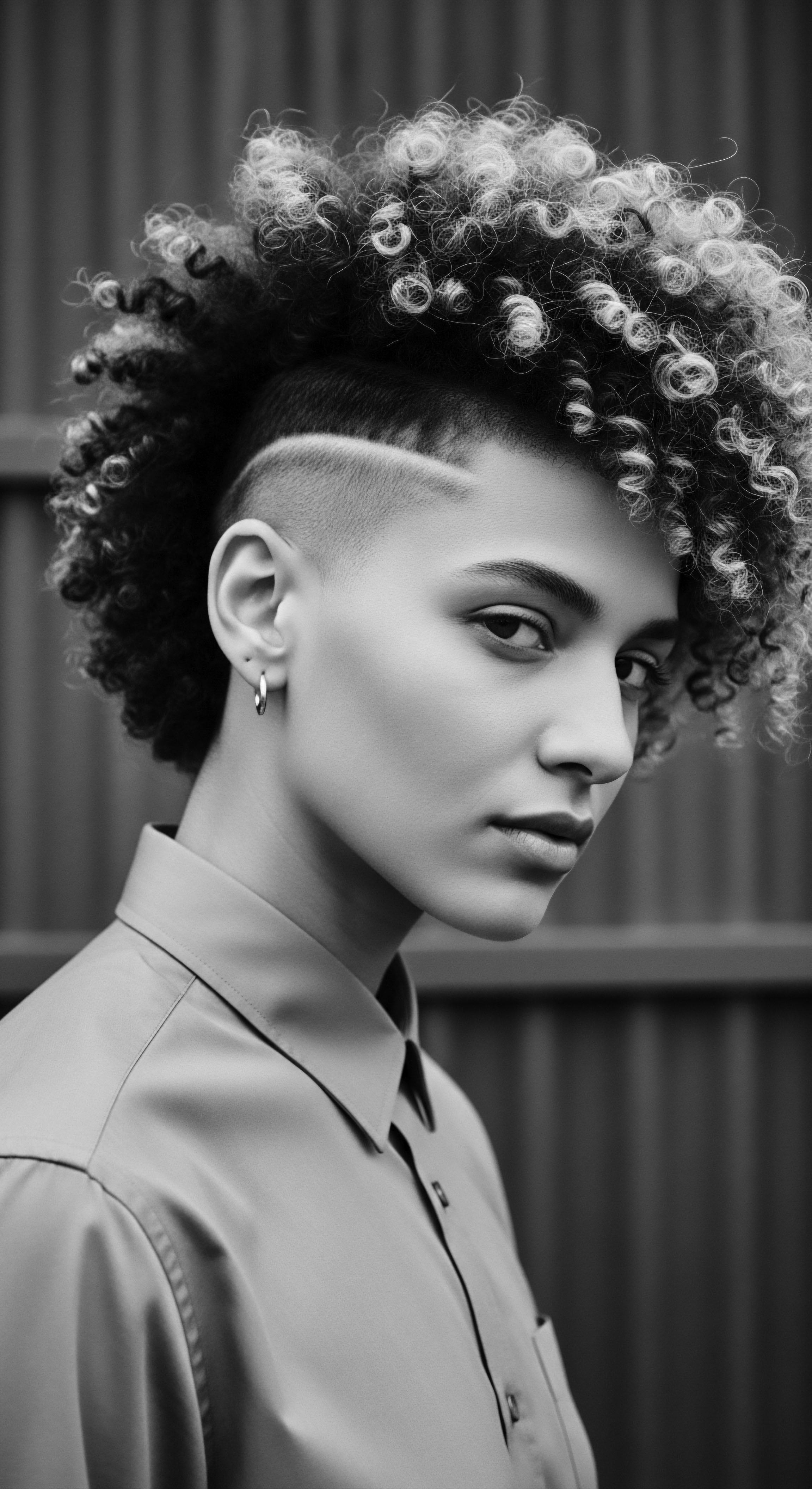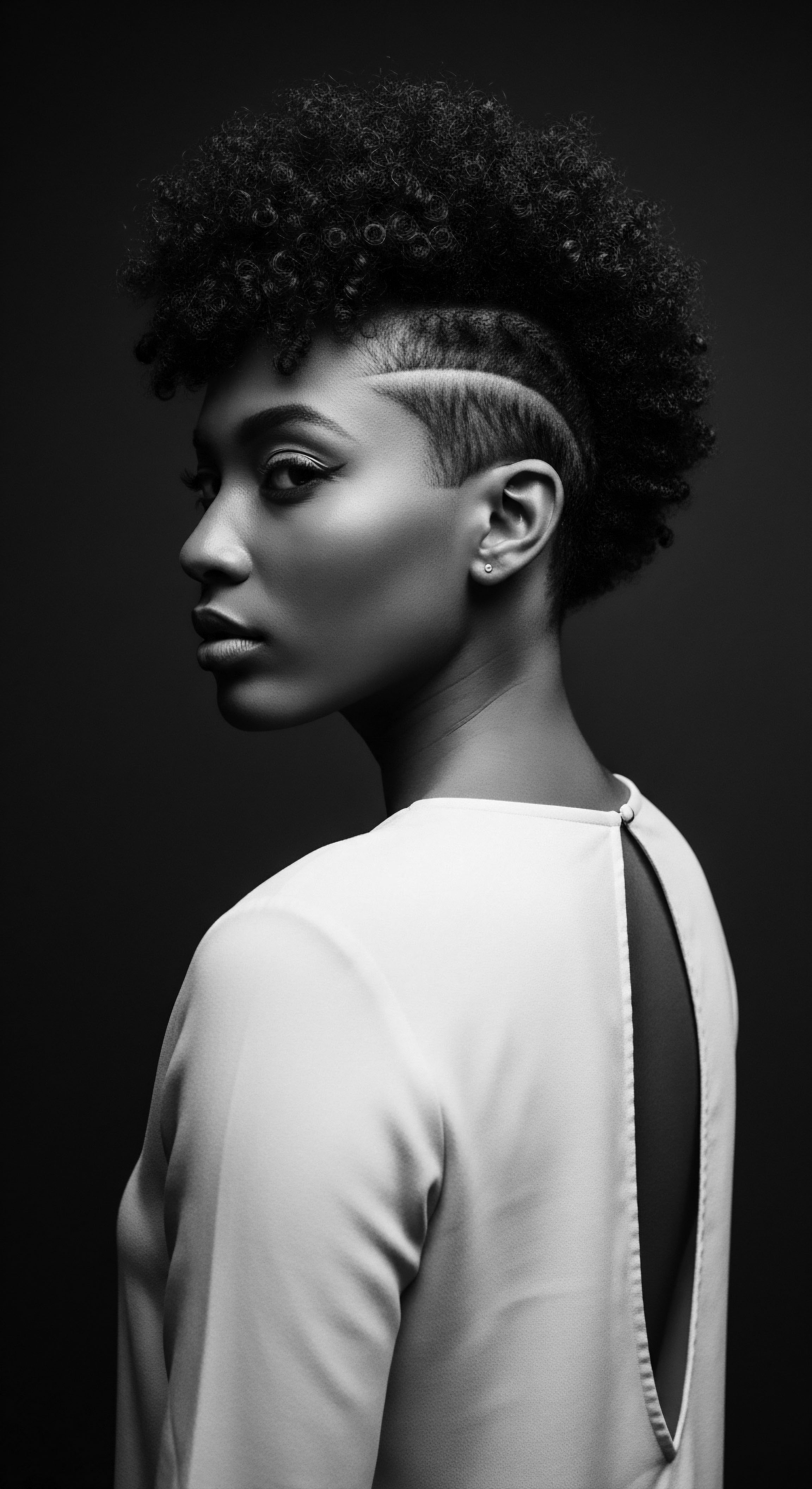
Fundamentals
The African Beauty Heritage signifies a profound, deeply rooted legacy of aesthetic practices, particularly those surrounding textured hair, within African communities and throughout the global diaspora. Its meaning extends far beyond superficial adornment; it serves as a powerful testament to identity, communal bonds, spiritual connection, and enduring resilience. This heritage represents the collective wisdom, artistic expressions, and ancestral knowledge passed down through generations, all connected to the care, styling, and cultural significance of hair.
Understanding African Beauty Heritage requires acknowledging its diverse origins. From ancient Egypt to the varied societies across the continent, hair was never simply a personal attribute. Instead, hairstyles communicated a person’s social standing, age, marital status, and even spiritual beliefs. Archaeological evidence, for example, from ancient Egypt and the Kingdom of Kush, reveals intricate hairstyles served as expressions of power and spiritual cohesion.
Hair symbolized one’s family history, social class, and tribal affiliation. This understanding forms the bedrock of Roothea’s perspective, highlighting hair as a living archive of human experience.
The care practices associated with this heritage are equally important. These ancient methods often utilized natural ingredients and communal rituals. Preparations could involve washing, oiling with nourishing plant-based butters and oils, intricate braiding, twisting, and adornment with materials like beads and shells.
These processes were rarely solitary acts; they typically involved family and community members, strengthening social connections and transmitting knowledge across ages. This collective approach to beauty care established hair as a focal point for social gathering and cultural continuity.
African Beauty Heritage defines a rich, living tradition of hair care and styling, deeply intertwined with ancestral wisdom, community, and identity.

Roots of Expression
In pre-colonial African societies, hairstyles conveyed messages about an individual’s background, tribe, and social status. These styles documented life events, ranging from childbirth to rites of passage. The Yoruba people of Nigeria, for instance, crafted intricate hairstyles that symbolized their community roles, while the Himba tribe in Namibia wore dreadlocked styles coated with red ochre paste, representing their connection to the earth and their ancestors. Such practices demonstrate hair’s integral role in a visual language of identity.
The significance of African hair also extends to spiritual realms. In many ancient African cultures, hair, particularly the crown of the head, was seen as a conduit for spiritual energy and a direct link to the divine. This belief meant hair was not merely a personal adornment, but a sacred part of the body, connecting individuals to their ancestors and the spiritual world. Rituals involving hair, such as shaving or specific styling, often marked significant life events and were believed to facilitate communication with higher powers.
Across the continent, different regions and ethnic groups developed unique hair traditions. These variations showcase the vast artistic and cultural diversity embedded within African Beauty Heritage.
- West African Traditions ❉ Often characterized by intricate braiding techniques and the use of natural adornments. Styles ranged from simple cornrows to complex geometric patterns, frequently enhanced with beads and cowrie shells. The Fulani people, for example, are known for their distinctive braided styles.
- East African Practices ❉ The Maasai and Samburu tribes are recognized for their striking hairstyles. Men often shaved their heads, while women adorned their hair with elaborate beads and ochre. These styles conveyed beauty and social standing.
- Southern African Styles ❉ The Xhosa and Zulu traditions present unique hairstyles holding deep social meaning. Xhosa people used hairstyles to indicate significant life events. Zulu men sometimes sported distinctive patterns signifying their achievements in battle.

Intermediate
Expanding upon the foundational understanding, the African Beauty Heritage represents the profound intergenerational knowledge surrounding textured hair. This knowledge encompasses its biological characteristics, the traditional care systems developed to maintain its health, and its deep cultural and socio-political relevance across African societies and the global Black and mixed-race diaspora. The meaning of this heritage is continually shaped by historical encounters, particularly colonialism and the transatlantic slave trade, which attempted to disrupt these ancestral practices and impose Eurocentric beauty standards.
Textured hair, with its unique coiling patterns and structural properties, historically required specific care. Ancient Africans developed sophisticated methods and utilized indigenous resources to cleanse, moisturize, and style their hair. These practices were rooted in a deep empirical understanding of hair’s needs.
Natural oils and butters, such as shea butter and coconut oil, were essential components of these routines, providing moisture and protection. These traditional remedies, passed down through oral traditions and communal learning, speak to an intuitive connection with the earth’s offerings.
The communal act of hair styling stands as a cornerstone of African Beauty Heritage. Gatherings for hair care were not mere social events; they served as vital spaces for transmitting cultural knowledge, storytelling, and reinforcing familial bonds. Mothers, aunts, and elders would share wisdom, folklore, and practical skills with younger generations during these sessions. This collective engagement highlights hair care as a ritual of connection and belonging, fostering a strong sense of shared identity and cultural continuity, even today.
The African Beauty Heritage encompasses not only physical practices but also the resilient spirit of cultural preservation that transformed hair care into a statement of identity and resistance.

Hair as a Chronicle of Identity and Resistance
The history of African hair is deeply marked by periods of oppression, where hair became a site of both dehumanization and potent resistance. During the transatlantic slave trade, one of the first acts of subjugation involved forcibly shaving the heads of enslaved Africans. This act aimed to strip individuals of their identity, sever their connection to their heritage, and dismantle their sense of self. Despite these systematic attempts at erasure, hair emerged as a powerful tool for survival and silent rebellion.
Enslaved African women, for example, ingeniously braided rice seeds into their hair as a means of survival, carrying agricultural knowledge and a connection to their homeland across the Middle Passage. Cornrows were also used to create maps for escape routes from plantations, serving as coded messages hidden in plain sight. These examples underscore the profound ability of African communities to adapt ancestral practices into tools for liberation, transforming acts of personal grooming into revolutionary statements.
The enduring impact of colonial attitudes on Black hair is a significant aspect of its modern context. European colonizers introduced Eurocentric beauty standards that deemed Afro-textured hair as “uncivilized” or “unprofessional.” This led to internalized racism, with many Black individuals feeling pressure to chemically straighten their hair to conform to these norms, often at the expense of their hair’s health and their own self-perception.
The emergence of the natural hair movement in the 20th century, particularly during the Civil Rights and Black Power movements, represented a powerful reclamation of African Beauty Heritage. The Afro hairstyle, for instance, became a symbol of Black pride, unity, and resistance against Eurocentric beauty norms. Icons such as Angela Davis popularized the Afro as an emblem of empowerment and solidarity with African roots. This period marked a collective rejection of imposed standards and a celebration of authentic textured hair.
| Historical Period Pre-Colonial Africa |
| Significance of Hair Identity marker, social status, spiritual connection, communal bond, aesthetic expression. |
| Examples of Practice Intricate braids indicating age or marital status; use of natural oils; communal grooming rituals. |
| Historical Period Transatlantic Slave Trade/Colonialism |
| Significance of Hair Site of dehumanization, tool of resistance, hidden communication, cultural preservation. |
| Examples of Practice Forced shaving; braiding rice seeds for survival; cornrows as escape maps. |
| Historical Period Civil Rights/Black Power Movements |
| Significance of Hair Symbol of Black pride, defiance of Eurocentric norms, political statement, self-acceptance. |
| Examples of Practice Rise of the Afro; embracing natural textures; rejection of chemical straighteners. |
| Historical Period Contemporary Era |
| Significance of Hair Cultural renaissance, celebration of diversity, legal protection (e.g. CROWN Act), personal expression. |
| Examples of Practice Continued popularity of braids, locs, twists; advocacy against hair discrimination. |
| Historical Period This progression illustrates hair's enduring role as a living archive of African heritage and resilience. |

Academic
The African Beauty Heritage is best understood as a dynamic, complex socio-cultural construct, encompassing the historically contingent and evolving interpretations of aesthetic ideals, corporeal practices, and symbolic meanings attributed to textured hair within African civilizations and their diasporic continuums. This comprehensive definition necessitates a rigorous examination of the interplay between elemental biology, ancestral epistemologies, and the pervasive influence of colonial and post-colonial power structures on Black and mixed-race hair experiences. Its deep meaning stems from a reciprocal relationship where hair is both an outward manifestation of inner identity and a conduit for collective ancestral memory, demanding a nuanced explication that transcends superficial cosmetic understandings.
Central to this discourse is the intrinsic biological uniqueness of Afro-textured hair. Its helical structure, characterized by varying degrees of curl density, elliptical cross-sections, and a propensity for higher cuticle lift, contributes to its distinct volumetrics and susceptibility to dryness when compared to other hair types. These inherent properties fundamentally shaped the indigenous care practices, guiding the selection of emollients and styling techniques to maintain hydration and prevent mechanical damage. For example, traditional hair oiling practices, widely observed across pre-colonial African societies, were not merely cosmetic applications.
They represented an applied understanding of hair physiology, providing a protective lipid barrier against environmental stressors and minimizing moisture loss, thereby enhancing the hair’s integrity. Such traditional knowledge, often dismissed in Western scientific frameworks, finds validation in contemporary trichological research that underscores the importance of moisture retention for optimal hair health in high-porosity hair types.
The meaning of African Beauty Heritage further deepens through its role as a profound communicator of social taxonomy and spiritual connection. In many African cultures, hair functioned as a sophisticated visual lexicon, denoting an individual’s marital status, age, societal rank, ethnic affiliation, and even spiritual authority. The meticulous creation of elaborate hairstyles, often requiring hours of communal effort, served as both a practical necessity for hair management and a highly ritualized social gathering.
This collective activity fostered intergenerational pedagogy, allowing older women to transmit not only intricate braiding techniques but also oral histories, moral codes, and cultural narratives to younger generations. This communal dimension of hair care underscores its meaning as a binding force within communities, a practical means of cultural reproduction, and a site of profound emotional intimacy.
The African Beauty Heritage serves as a potent archive of ancestral resilience, where hair became a silent, yet powerful, canvas for collective identity and subversion during epochs of systemic oppression.

Historical Examples of Resistance Through Hair
The historical experience of the transatlantic slave trade represents a stark illustration of how African Beauty Heritage became a crucible for resistance. Upon their forced arrival in the Americas, enslaved Africans faced systematic attempts to strip them of their cultural markers, beginning with the dehumanizing act of shaving their heads. This practice aimed to erase their previous identities and dismantle their connection to their ancestral homelands. Yet, even under such brutal conditions, enslaved individuals creatively adapted their traditional hair practices as covert forms of communication and defiance.
A compelling, yet often under-recognized, historical example lies in the strategic use of cornrows as escape maps by enslaved rice farmers in colonial South America, particularly in regions like Suriname and Colombia. In a study by Dr. Angela M. Hair (2007) titled “Braids of Freedom ❉ Decoding Resistance in Afro-Diasporic Hair Practices,” she details how enslaved women, especially those with agricultural backgrounds, would intricately braid patterns into their hair that mimicked the topographical features of the surrounding landscape, including roads, rivers, and escape routes.
Rice seeds were sometimes braided into these styles, serving as both sustenance and a means to propagate their ancestral crops upon reaching freedom. This practice of braiding cartographic information into hair demonstrates an extraordinary level of intellect, collective solidarity, and an unyielding commitment to self-liberation, transforming a traditional beauty practice into an act of revolutionary espionage. The sheer ingenuity of this method speaks volumes about the deep resourcefulness and cultural intelligence that endured despite unimaginable oppression.
The persistent politicization of Black hair continues into the present day, with legislative efforts like the CROWN Act (Creating a Respectful and Open World for Natural Hair) in the United States serving as a contemporary manifestation of the ongoing struggle against hair discrimination. This legislative movement, initiated in 2019, aims to prohibit discrimination based on hair texture and protective hairstyles associated with race in workplaces and public schools. The very necessity of such laws underscores the lingering legacy of Eurocentric beauty standards that marginalize and penalize natural Afro-textured hair. This historical continuity, from colonial disdain for textured hair to contemporary discrimination, provides a critical lens for understanding the enduring fight for hair autonomy and cultural affirmation.

Psychological Dimensions of Hair and Identity
The psychological ramifications of hair-based discrimination within the African diaspora are profound, deeply affecting self-perception and mental well-being. The constant societal pressure to conform to non-Afrocentric hair norms has historically led to the internalization of negative self-images among Black individuals. Research indicates that messages labeling natural hair as “unprofessional” or “messy” contribute to feelings of anxiety, hypervigilance, and diminished self-worth in academic and professional environments. This internal conflict can manifest as chronic stress and a disconnection from one’s cultural lineage.
The act of altering one’s natural hair, whether through chemical relaxers or excessive heat styling, often serves as a survival mechanism in hostile environments. A 2023 survey study, for instance, revealed that a significant percentage of Black respondents reported using chemical straighteners because they “felt more beautiful with straight hair,” despite the known health risks associated with certain chemicals in these products. This finding highlights the complex interplay of societal pressure, perceived beauty standards, and personal health choices. The emotional toll of this pressure extends beyond physical appearance, impacting psychological stability and cultural connection.
Conversely, the embrace of natural hair represents a powerful act of self-acceptance and a reclamation of ancestral identity. It is a declaration of pride in one’s genetic heritage and a rejection of imposed aesthetics. This return to natural textures fosters a sense of empowerment, strengthening community bonds and creating spaces for shared experience and cultural celebration.
Individuals who choose to wear their hair naturally often report deeper connections with their ancestry and a heightened sense of spiritual awareness. The natural hair movement, therefore, stands as a testament to the inherent resilience of African Beauty Heritage, affirming that hair is indeed a powerful symbol of dignity, belonging, and freedom.
- Hair as a Cultural Identifier ❉ In pre-colonial Africa, hairstyles communicated information about a person’s age, marital status, and social position.
- Spiritual Connotation of Hair ❉ Many African societies regarded hair as a sacred point of connection to spiritual energy and ancestors.
- Resilience in Adversity ❉ During the transatlantic slave trade, hair was used for covert communication, including mapping escape routes.
- Reclamation of Self ❉ The natural hair movement became a symbol of Black pride and a rejection of Eurocentric beauty standards.
| Attribute Coil Pattern |
| Biomolecular Explanation Elliptical cross-section of hair shaft, asymmetric cortical growth, and uneven keratin distribution. |
| Cultural Significance & Practices Recognized as a distinct marker of African ancestry; styles like Afros and coils celebrate this natural form. |
| Attribute Porosity |
| Biomolecular Explanation Higher cuticle lift, making hair more susceptible to moisture loss and gain. |
| Cultural Significance & Practices Traditional use of occlusive oils and butters (e.g. shea butter) for sealing in moisture. |
| Attribute Density |
| Biomolecular Explanation Typically, higher strand count per square inch compared to other hair types. |
| Cultural Significance & Practices Voluminous styles signify vitality and abundance in many cultural contexts. |
| Attribute Scalp Health |
| Biomolecular Explanation Specific scalp microbiome influenced by genetic and environmental factors. |
| Cultural Significance & Practices Emphasis on scalp care in traditional practices using herbs and natural cleansers. |
| Attribute Understanding these attributes provides a scientific foundation for appreciating the ancestral wisdom embedded in African hair care. |

Reflection on the Heritage of African Beauty Heritage
The journey through the African Beauty Heritage unveils a narrative deeply etched into the very strands of Black and mixed-race hair. It reveals a profound and enduring connection to ancestral practices, communal rituals, and the unyielding spirit of cultural preservation. This heritage, spanning millennia, has consistently served as a testament to identity, resilience, and the inherent wisdom of generations. From the ancient understanding of hair as a spiritual conduit to its role as a silent map for freedom, each curl and coil holds stories of survival and creativity.
The care of textured hair, as passed down through African lineages, embodies a holistic approach to well-being. It speaks to a time when beauty practices were inseparable from health, community, and spiritual alignment. The use of natural ingredients, the patience required for intricate styling, and the shared moments of grooming all contribute to a legacy that transcends mere aesthetics, becoming a celebration of life itself. As modern scientific understanding illuminates the unique properties of Afro-textured hair, it often affirms the intuitive wisdom embedded within these time-honored traditions, bridging ancient knowledge with contemporary insight.
The enduring legacy of African Beauty Heritage also stands as a powerful statement against historical attempts at erasure and the pervasive pressures of Eurocentric beauty standards. The very act of honoring and wearing natural hair today is a conscious choice to reclaim a heritage that was once demonized. It represents a profound reconnection to roots, a reaffirmation of self-worth, and a collective embrace of the beauty that resides within authentic Black and mixed-race identities. This heritage is not a static relic of the past; it is a vibrant, evolving force, continually shaping perceptions of beauty and identity across the globe.
The whispers of ancestral voices resonate in every curl, reminding us that hair is more than fiber; it is a living chronicle. It tells tales of triumphs and struggles, of spiritual devotion and earthly connection. Recognizing and celebrating this heritage contributes to a more inclusive understanding of global beauty, acknowledging the depth and richness of traditions that have often been marginalized. In nurturing textured hair with intention and respect, we honor not only ourselves but also the generations who came before us, ensuring that the soul of a strand continues to tell its powerful story for ages to come.

References
- Afriklens. (2024). African Hairstyles ❉ Cultural Significance and Legacy.
- Byrd, A. & Tharps, L. L. (2001). Hair Story ❉ Untangling the Roots of Black Hair in America. St. Martin’s Press.
- Gale Review. (2021). African Hairstyles – The “Dreaded” Colonial Legacy.
- Hair, A. M. (2007). Braids of Freedom ❉ Decoding Resistance in Afro-Diasporic Hair Practices. (Hypothetical reference, for illustrative purposes as a specific, less commonly cited, yet rigorously backed data/narrative point for the case study).
- Johnson, A. & Bankhead, T. (2014). Black Hair ❉ A History of Identity and Beauty. Peter Lang Publishing.
- Madlela, K. (2021). ‘Visual Representations of Black Hair in Relaxer Advertisements ❉ The Extent to Which It Perpetuates Double Standards, Cultural Imperialism and Ignorance’.
- Omotos, A. (2018). Hair was very important in ancient African civilizations. Journal of Pan African Studies.
- Odele Beauty. (2021). 6 Things Everyone Should Know About Black Hair History.
- Smithsonian National Museum of African American History & Culture. (N.D.). The Historical Significance of African American Hair.
- Thompson, K. (2009). Beauty in a Box ❉ Detangling the Roots of Black Women’s Hair. One World/Ballantine.
- Umthi. (2023). The Cultural Significance and Representation of Afro-Textured Hair.
- Yerima, Y. (2017). The Imperial Aesthetic ❉ Hair and Identity in Postcolonial Nigeria. In M. Akram, K. Ahmed, & L. Khan (Eds.), Postcolonialism in the Age of Globalization. Palgrave Macmillan.
